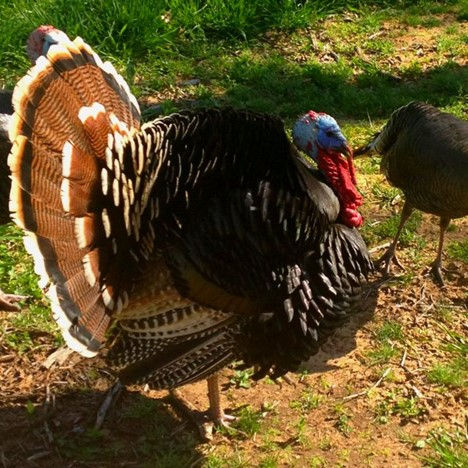Wild Turkey: Not Just a Bourbon
- nancywagoner
- Jul 10, 2022
- 3 min read

The first time I spotted a flock of wild turkeys, I was amazed—there must have been over twenty hens walking around my yard and cove. It still delights me to look out my breakfast window and see one of these wild creatures—they don’t seem too bothered by my presence. These odd birds waddle around pecking at the ground, but sometimes move together swiftly through the meadow and neighborhood. In fact, they can reach a speed of 50 miles per hour but most likely when they are being chased by a predator. Because we are so used to seeing photographs of domestic and over-bred turkeys, we hardly recognize these New World native birds. Compared to their domestic counterparts, the wild turkey is more intelligent, more agile, and an excellent forager. Wild turkeys are native birds in the Hill Country although populations have been declining over the past 40 years for unknown reasons.
Turkey Facts
When Benjamin Franklin suggested the wild turkey as our national bird, we can imagine he appreciated its fascinating characteristics and charm. Although the turkey lost by just one vote to the bald eagle, its keen senses make it one of America's favorite game birds. By the early 20th century, North America almost lost its wild population of turkeys due to hunting and destruction of native habitat—the population was down to 30,000. Fortunately, thanks to preservation and breeding efforts, there are estimated to be seven million now throughout the United States. Their excellent vision and hearing make them challenging game for Texas hunters. I have a friend who used to go turkey hunting frequently, but I don’t ever recall him actually getting one. I was secretly always a little glad they had outsmarted him once again!

Wild turkeys have over 5,000 to 6,000 feathers and will eat almost anything that fits in their mouth. They forage for insects, snails, and other invertebrates. Major food items during the spring and summer include green grasses and weeds, buds, flowers, seeds, and insects. Insects are especially important for the development of young turkeys by providing them with a high protein food source. In fall and winter, they eat fruits, pecans and acorns, and green forage such as Texas winter grass, oats, wheat, and clovers depending upon their availability.
Although turkeys spend most of their time on the ground during the day, they sleep in trees at night. Turkeys cannot see well in the dark, so sleeping in trees provides protection from predators. They fly up to roost at dusk and fly down at dawn to begin their daily routines.
In late winter, turkeys divide into smaller groups: hens, young males and old gobblers. Later in the spring, the males select and defend a territory against all competitors for a harem of hens. Each morning, they call to and court as many hens as they can lure away from neighboring gobblers. The males show off their grand tail fans during courtship, and occasionally fight one another. Breeding rites are performed from February through May. Afterward, nesting hens go off by themselves and create a well-screened, but thrown-together nest located on the ground concealed by brush and low vegetation. Hens lay seven to 20 eggs, but the average is about 12. Once her eggs are hatched, the hen seldom leaves the nest for 28 days. Pink/brown poults emerge from the eggs, leave the nest very shortly, and immediately begin feeding on invertebrates (insects, spiders, etc.). Poults begin awkward small flights at about two weeks. The family group of a hen and her poults is called a brood. The brood feeds, roosts and loafs together until large flocks congregate in late autumn.
Turkey Talk
Sometimes you will hear them instead of seeing them—but here’s how to tell if they are chattering around your house as they have a varied and distinct vocabulary:
a contented purr that might surprise you:
to a yelp that sounds almost like a dog barking:
to the more familiar gobble that can sometimes be heard up to a mile away.
Good or Bad Traits
I have not noticed any damage from the turkeys wandering around outside and around my house—I don’t seem to miss anything that they are eating, and they haven’t damaged any of my new landscape plants. They have not nibbled on flowers either. I haven’t even noticed any poop which is strange. If you have a vegetable garden, there is a possibility they will snack on something, but if your garden is eaten at night, it is not a turkey!

http://visitwimberley.com/ourbirds/wildturkey.shtml Visit Wimberley.com
Jurica, Jenny Webster. “Five Texas Wild Turkey Facts”, https://texashillcountry.com/5-texas-wild-turkey-facts/ Texas Hill Country 16 October 2017
Indiana Department of Natural Resources
Article provided by Alison Henley

Comments